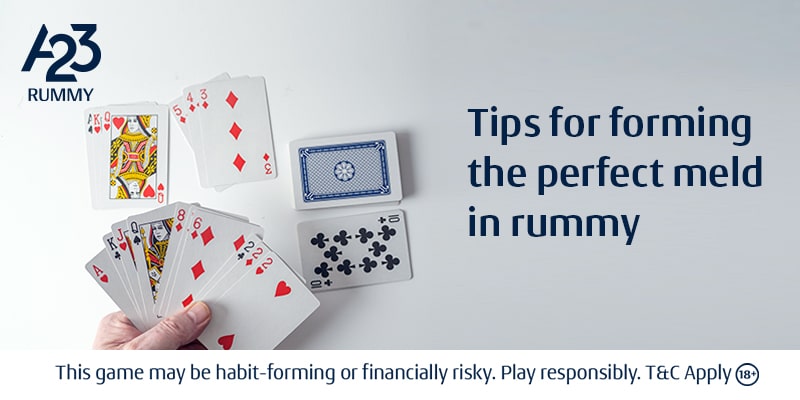
Indian rummy is a popular card game that combines skill and strategy with a lot of patience. Whether you have played the game before or are still learning how to play, understand the basics of rummy and the strategies required to claim victory. In this blog, we will explore the different aspects of melding in rummy and why they are important.
What is melding in rummy?
In Indian rummy, players need to meld together sequences and sets for a valid declaration, but what does that mean? As per rummy rules, you need valid sets and runs along with a pure sequence to win the game.
In rummy terms, melding involves building sets of 3 or more cards of the same rank but different suits, for example, 9♠ 9♣ 9♥. Alternatively, melds that are a collection of cards in a sequence of the same suit are known as runs, for example, 9♠ 10♠ J♠. Melding in rummy is the core of rummy variations such as canasta and gin rummy. Being well-versed in melding in rummy will help you determine the best course of action during the game and minimise the points received through unmatched/unmelded cards. It’s important to keep in mind that both sets and runs need a minimum of three cards for sets and four cards for runs to be declared valid melds.
- Melding in rummy
Forming melds at the beginning of the game can reduce a very important aspect of Indian rummy: deadwood. While melding in rummy, deadwood can change the game. Deadwood refers to cards that have not been matched and can invite penalty points at the end of the rummy game. By effectively melding rummy sets and runs, you can increase the chance of strategic discards and create game-winning combinations that can help you win at Indian rummy.
2. Aim for high-value cards:
Your first activity after sorting your cards should be to club the potential sets or runs together and they should include high-value cards. In Indian rummy, all cards have points, but face cards such as K Q and A have the highest points. Use them wisely
3. Analyse your hand
Use middle cards like 2s or 5s, which can work with A, 2, 3, 5, 6, or 7. For example, 6♥ can be used to create a combination with 4♥, 5♥, 6♥, and 7♥. Alternatively, 2♥ can only be used to form a meld with A♠, 3♠, and 4♠. Melding in rummy is all about choosing the right combination.
4. Make it Pure
A pure sequence is a group of consecutive cards of the same suit, for example, 4♥, 5♥, 6♥, and 7♥. A valid pure sequence without a joker is a must to declare rummy and can be the game changer.
5. Bluffing
Bluffing can be a great move if you are in a difficult position. You can discard a card you think they may need, depending on the cards they have discarded. This can upset your opponent’s strategy, leading them to make a mistake.
6. Joker Power
Jokers can be your biggest asset when melding in rummy. There are two types of jokers: a printed joker and a wildcard joker. Both of these can be used as replacements for missing cards in a set, run or impure sequence. Whereas only a wildjoker can be used in a pure sequence. Use your joker wisely while melding in rummy.
7. Practice
Learning theory is a good start, but putting your knowledge to the test is important. Download the A23 rummy app and get going. Learn new tricks for melding in rummy as you play multiple tournaments. As a rookie, start by playing free tournaments. A23 has a variety of free tournaments.
In the end, it is crucial to be flexible and adaptable as the game progresses. Keeping track of your opponents and their cards can take you a long way in a rummy game. Plan your melding in rummy wisely to win.




 Apr 12, 2024
Apr 12, 2024
Note: that your message will not be displayed until it is reviewed by the moderator!